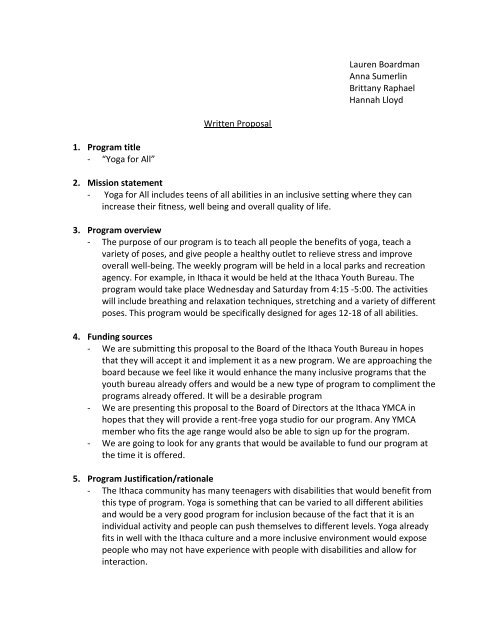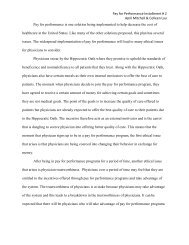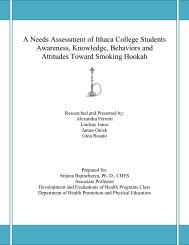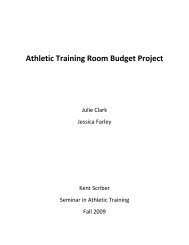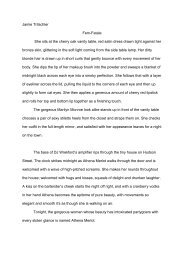Lauren Boardman Anna Sumerlin Brittany Raphael Hannah Lloyd ...
Lauren Boardman Anna Sumerlin Brittany Raphael Hannah Lloyd ...
Lauren Boardman Anna Sumerlin Brittany Raphael Hannah Lloyd ...
Create successful ePaper yourself
Turn your PDF publications into a flip-book with our unique Google optimized e-Paper software.
1. Program title<br />
- “Yoga for All”<br />
Written Proposal<br />
<strong>Lauren</strong> <strong>Boardman</strong><br />
<strong>Anna</strong> <strong>Sumerlin</strong><br />
<strong>Brittany</strong> <strong>Raphael</strong><br />
<strong>Hannah</strong> <strong>Lloyd</strong><br />
2. Mission statement<br />
- Yoga for All includes teens of all abilities in an inclusive setting where they can<br />
increase their fitness, well being and overall quality of life.<br />
3. Program overview<br />
- The purpose of our program is to teach all people the benefits of yoga, teach a<br />
variety of poses, and give people a healthy outlet to relieve stress and improve<br />
overall well-being. The weekly program will be held in a local parks and recreation<br />
agency. For example, in Ithaca it would be held at the Ithaca Youth Bureau. The<br />
program would take place Wednesday and Saturday from 4:15 -5:00. The activities<br />
will include breathing and relaxation techniques, stretching and a variety of different<br />
poses. This program would be specifically designed for ages 12-18 of all abilities.<br />
4. Funding sources<br />
- We are submitting this proposal to the Board of the Ithaca Youth Bureau in hopes<br />
that they will accept it and implement it as a new program. We are approaching the<br />
board because we feel like it would enhance the many inclusive programs that the<br />
youth bureau already offers and would be a new type of program to compliment the<br />
programs already offered. It will be a desirable program<br />
- We are presenting this proposal to the Board of Directors at the Ithaca YMCA in<br />
hopes that they will provide a rent-free yoga studio for our program. Any YMCA<br />
member who fits the age range would also be able to sign up for the program.<br />
- We are going to look for any grants that would be available to fund our program at<br />
the time it is offered.<br />
5. Program Justification/rationale<br />
- The Ithaca community has many teenagers with disabilities that would benefit from<br />
this type of program. Yoga is something that can be varied to all different abilities<br />
and would be a very good program for inclusion because of the fact that it is an<br />
individual activity and people can push themselves to different levels. Yoga already<br />
fits in well with the Ithaca culture and a more inclusive environment would expose<br />
people who may not have experience with people with disabilities and allow for<br />
interaction.
6. Program goals<br />
- To improve the well being of all participants by providing an inclusive environment<br />
- To improve flexibility<br />
- To improve strength<br />
- To improve overall physical fitness<br />
- To improve balance<br />
- To improve mindfulness and spirit<br />
- To increase stamina<br />
- To strengthen muscles<br />
- Greater lung capacity<br />
- Reduced levels of stress, tension and anxiety<br />
- Improved mental clarity and focus<br />
- Improved sense of well being<br />
- Increased feelings of connection, less isolation<br />
- More restful sleep<br />
(May All Be Happy, 2008)<br />
7. Anticipated benefits for participants with and without disabilities, families,<br />
community<br />
- This yoga program would benefit people with and without disabilities by improving<br />
well being, flexibility, self-awareness and socialization. This program will allow<br />
parents to bring their children to a safe environment where they will benefit from<br />
physical activity. For the community, it would show everyone how much people with<br />
disabilities are capable of and how important it is that they are included in programs<br />
and that we can learn from them too.<br />
8. Program plan<br />
a. Individual needs/interests/abilities assessment<br />
Each participant will be required to fill out an intake form. This way the teachers will<br />
be aware ahead of time about individual needs since each participant will have such<br />
varying abilities. Our intake form is designed so that the instructor can plan ahead<br />
for what accommodations and adaptations will be needed for individuals. Certain<br />
questions on the intake form can be used as a means of evaluating individual<br />
progress throughout the course. In addition, if needs are assessed and it is<br />
determined that adaptations and accommodations will be needed; an interview will<br />
be scheduled with the family to discuss how instructor can best suit the needs of the<br />
individual participating in the program. For intake form see attached, appendix A.<br />
b. Staffing<br />
The staff needed for this program would include one yoga teacher who is also<br />
trained in teaching those with disabilities. Additional staff might be necessary for<br />
those who need one- on-one assistance. We would recruit instructors by advertising<br />
at local schools, yoga studios and organizations that serve youth with disabilities.
This option would be provided for. If any participant already has a full time aide<br />
they are permitted to attend the program free of charge.<br />
c. Staff training<br />
The instructor will be required to have a Registered Yoga Teacher Certificate from<br />
the Yoga Alliance, a nationally recognized organization. In addition to this the<br />
teacher will be required to have some sort of past experience in inclusion and/or<br />
inclusion training. If the teacher has no past experience they will be required to go<br />
through a course similar to Inclusion U or the equivalent that is offered in the area<br />
to receive an inclusion certificate.<br />
Staff Training Plan<br />
I. Historical background of inclusion (15 minutes)<br />
History of institutionalization<br />
Deinstitutionalization<br />
Normalization theory<br />
II. Importance of inclusion (40 minutes)<br />
What is inclusion?<br />
Inclusion terms<br />
What is NOT inclusion<br />
Benefits of inclusion<br />
Segregated vs. inclusive programs<br />
Barriers of inclusion (attitudinal, architectural, programmatic,<br />
administrative)<br />
III. Rationale for inclusion (10 minutes)<br />
Self-Determination<br />
IV. Person first language (10 minutes)<br />
What is person first language?<br />
Examples<br />
What NOT to say<br />
V. Inclusion strategies (30 minutes)<br />
Behavioral Techniques<br />
VI. Types of adaptive equipment (10 minutes)<br />
Incorporating chairs for all participants<br />
VII. Ways of adapting to create yoga experience for all (20 minutes)<br />
Adapting poses<br />
Breathing techniques<br />
How to incorporate aides properly (fading)<br />
VIII. Social inclusion (30 minutes)<br />
Principles of social inclusion<br />
Cooperation<br />
Friendship Development<br />
(Heyne, 2009)
d. Networking<br />
We will collaborate with local schools and other recreation programs. We will call<br />
the local superintendant to get in contact with schools and ask their permission to<br />
advertise on their grounds. The local schools can advertise the programs and hand<br />
out information to those who wish to learn more about it. The other recreational<br />
programs at the youth bureau can also advertise the program and possibly provide<br />
new ideas for implementation.<br />
e. Equipment/materials<br />
- Yoga mats<br />
- Yoga blocks<br />
- Stretching bands<br />
- Chairs<br />
f. Budget and budget justification<br />
Since we plan on using the YMCA for our program most of the materials will already<br />
be present. The YMCA already provides yoga classes, but not specifically for those<br />
with disabilities. We would already have use of their mats, blocks, and stretching<br />
bands. In addition to the already provided equipment we would need to buy and<br />
adaptive equipment necessary. Participants of the program would pay a fee of $50<br />
for the six week session. Scholarships are available through the youth bureau for<br />
those in need. The fee charged will cover the staff and any left over money will go<br />
to the Ithaca youth bureau. The estimated advertising costs around $50 dollars. This<br />
includes the flyers distributed to schools, the YMCA, and the youth bureau.<br />
COSTS<br />
Yoga Mats – provided<br />
Yoga Blocks – provided<br />
Stretching bands – provided<br />
Chairs – borrowed from YMCA<br />
Advertising costs - $ 50 dollars<br />
Instructor fee - $35 dollars per session * 12 total sessions = $420.00<br />
TOTAL COSTS = $470.00<br />
REVENUE<br />
# Participants = 12 * $ 50.00 each = $600.00<br />
TOTAL REVENUE = $600.00<br />
TOTAL PROFIT = $130.00
g. Timeline for assessment, planning, implementation, and evaluation<br />
September/ October<br />
- Flyers will be handed out to local schools and youth serving organization in<br />
early September<br />
- When people register they will fill out the intake form.<br />
November/December<br />
- Registration will end November 14 th .<br />
- Beginning November 15 th , program administrators will assess the needs of<br />
each participant and come up with a plan for implementation for successful<br />
inclusion.<br />
- Program will run from beginning of November to mid-December. It will start<br />
November 28 th and will end January 3 rd .<br />
January<br />
- Program will end January 3 rd .<br />
- Participants and parents will be asked to fill out evaluation forms.<br />
- Staff will also be asked to meet and discuss program success and brainstorm<br />
for future improvements<br />
9. Implementation Procedures<br />
a. Barriers that need to be overcome and how you plan to overcome them<br />
The internal barriers that would need to be overcome are staffing and staff training.<br />
Since this yoga program is designed to be inclusive, we would need to be certain<br />
that the teacher had the proper training for facilitating an inclusive environment.<br />
The external barriers that need to be overcome are stereotypes but we will try to<br />
overcome this by using ice breakers and using techniques of social inclusion.<br />
There will not be architectural barriers because we are using an accessible facility.<br />
b. Curriculum and instructional strategies<br />
Instructor will teach a variety of poses to all participants and will know how to adapt<br />
them so participants can either do them from the yoga mat or from a chair or<br />
wheelchair.<br />
Some poses and stretches that will be taught<br />
- Cat Pose<br />
o Grip your chair or place your hands on your thighs<br />
o Exhale as you round your upper body forward, dropping your chin<br />
toward your chest, arching your spine like a cat<br />
o Hold in this position for a few deep breaths<br />
- Cow Pose<br />
o Inhale, lengthen through your spine
o Exhale, lift your knee as high as it will go comfortably. Reach your<br />
hands around your shin or the back of your leg so you can support<br />
your leg as you stretch<br />
o Hold for 3-5 breaths. Continue breathing deeply as you hold the<br />
stretch<br />
o Gently come out of the stretch<br />
- Side Stretch<br />
o Inhale and lift one arm up over your head, bring your other arm to<br />
your hip, or on your arm rest for support<br />
o Exhale your body to the opposite side<br />
o Hold the pose for 3-5 breaths as you continue to breathe deeply<br />
o Inhale come back to center and switch sides<br />
- Leg Stretch<br />
o Inhale, lengthen through your spine<br />
o Exhale, lift your knee as high as it will go comfortably. Reach your<br />
hands around your shin or the back of your leg so you can support<br />
your leg as you stretch<br />
o Hold for 3-5 breaths. Continue breathing deeply as you hold the<br />
stretch<br />
o Gently come out of the stretch<br />
(May All Be Happy, 2008)<br />
c. Social inclusion strategies<br />
For the purposes of our program yoga will be done as a group in a circle instead of<br />
separate rows. On the first day of the program we will go around in a circle and<br />
everyone will introduce themselves and we will play an icebreaker game. Everyone<br />
will also make name tags so people can interact and learn each other’s names. The<br />
teacher will stress that each person has individual levels of abilities and therefore<br />
everyone should strive for what they believe they are capable of doing. It will also be<br />
stressed that if someone needs help they can ask anyone. If a participant has an aide<br />
the aide will be talked to before the class about possibly using fading so the<br />
participant can accomplish more on their own.<br />
d. Programmatic adaptations and modifications<br />
Modified poses will be used throughout the program. Also some poses will require<br />
all participants to be in a chair so everyone has the same experience with those<br />
certain poses. Other than that no other adaptations or equipment is needed.<br />
Visual Impairments<br />
For people with visual impairments we will explain the steps very clearly and<br />
loud for them to be able to hear. We can also use physical guidance if necessary.<br />
Hearing Impairments
By observing and watching people with hearing impairments will be able to<br />
follow along by mimicking what the instructor does.<br />
Physical Disabilities<br />
People with physical disabilities will be able to relax and sit comfortably on the<br />
mats and stretch out. They will have the option of sitting in a chair or staying in a<br />
wheelchair if they use one<br />
Cognitive Disabilities<br />
We will clearly explain the steps for each pose and will be able to answer any<br />
questions that arise.<br />
e. Program monitoring<br />
At various times, an inclusion specialist employed by the youth bureau would be<br />
asked to come in and check on the program and make sure that everything is being<br />
facilitated properly and that inclusion is successful. The inclusion specialist will also<br />
report about the yoga teacher and if they are doing a good job running the program.<br />
Yoga instructor will be certified and will not require much monitoring.<br />
10. Evaluation<br />
a. Instruments and processes for data collection and analysis<br />
We will evaluate the program through an evaluation form that all participants will be<br />
asked to complete at the end of the program. There will also be a parent/guardian<br />
evaluation form for each participant’s parent/guardian to fill out. Both forms are<br />
attached.<br />
b. Methods and sources for dissemination – with whom will you share the<br />
results? How will the results be shared?<br />
The information collected from the evaluations will be shared with parents after the<br />
results are complied. They will be available for pick up at the Racker Center, YMCA,<br />
and Ithaca Youth Bureau. Depending on the results, we plan to publish an article<br />
discussing the benefits of inclusive yoga programming and the benefits we observed.
Proposal<br />
Bibliography<br />
Heyne, L. (2009). “Inclusive community leisure services syllabus.”<br />
Pizer, A. (n.d.). What are the Health Benefits . In Benefits of Yoga . Retrieved September 8, 2008,<br />
from http://yoga.about.com/od/beginningyoga/a/benefits.htm<br />
May All Be Happy. (2008). "Wheelchair Yoga” Web. 10 Dec. 2009.<br />
http://mayallbehappy.org/wheelchair-yoga/<br />
Registration Forms<br />
Anderson, L., & Kress, C. B. (2003). Inclusion: Including People with Disabilties in Parks and<br />
Recreation Opportunities . State College, PA: Venture Publishing Inc.<br />
Registration Form. (n.d.). Wilderness Inquiry.<br />
http://www.wildernessinquiry.org/<br />
APPENDIX A
Name _____________________<br />
Date of Birth ___________________<br />
Gender (please circle) Female Male<br />
Yoga for All Registration Form<br />
Please rate your upper body strength from 1-5 with 1 being not very strong and 5 being very strong<br />
1 2 3 4 5<br />
Can you stand without support? Yes No<br />
Rate your flexibility from 1-5 with 1 being not very strong and 5 being very strong<br />
1 2 3 4 5<br />
Please rate your general physical fitness level from 1-5 with 1 being not very strong and 5 being very<br />
strong<br />
Do you take any medications? Yes No<br />
1 2 3 4 5<br />
Do you have any sensory, physical, cognitive or emotional disabilities? (please circle)<br />
Yes No<br />
If yes please list them and state how they affect you<br />
_____________________________________________________________________________________<br />
_____________________________________________________________________________________<br />
______________________________________________
Do you use any assistive devices? If yes please list them below<br />
_____________________________________________________________________________________<br />
_____________________________________________________________________________________<br />
______________________________________________<br />
Please circle any of the following that you have experienced:<br />
Arthritis<br />
Acid reflux<br />
Asthma<br />
Developmental disabilities<br />
Diabetes<br />
Head injury<br />
Incontinence<br />
Mental illness<br />
Seizure<br />
Stroke<br />
Do you have health insurance? Yes No<br />
If so, what is the policy number _______________________________<br />
Emergency contact info<br />
Name ______________________<br />
Relationship to participant __________________<br />
Address __________________________<br />
Phone _____________________
Today's Date_____________<br />
What do you like about yoga class?<br />
What do you dislike about yoga class?<br />
Did the staff create a positive experience for you?<br />
APPENDIX B<br />
Yoga for All Evaluation Form<br />
Is the instructor clear in giving instructions and demonstrating poses during class?<br />
Do you feel challenged physically in class? Do you feel like physical ability has improved for you<br />
personally?<br />
What would you add to the class that would make it a more positive experience?<br />
What, if anything, would you change about the class?
If there was one thing you would like to see in class whether it is a specific pose or exercise; a routine or<br />
instruction, what would it be?<br />
Please list three things you learned in this class:<br />
1.<br />
2.<br />
3.<br />
Do you feel that you made new friends through this program?<br />
Do you feel like your flexibility has improved?<br />
Not at all A little Somewhat A lot<br />
Do you feel like your strength has improved?<br />
Not at all A little Somewhat A lot<br />
Do you feel like your balance has improved?<br />
Not at all A little Somewhat A lot<br />
Do you feel like your stamina has improved?<br />
Not at all A little Somewhat A lot
Do you feel like your muscle strength has improved?<br />
Not at all A little Somewhat A lot<br />
Additional Comments:<br />
Thank you for your feedback!
Today's Date_____________<br />
APPENDIX C<br />
Yoga for All Evaluation Form<br />
(Parent/Guardian)<br />
Do you feel that this program was beneficial to your child? (Please Circle)<br />
What do you feel worked well?<br />
If anything, what do you feel did not work?<br />
Please provide any suggestion for improvement:<br />
YES NO<br />
Thank you!


